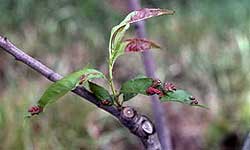Peach leaf curl
Peach leaf curl is mainly a disease of peaches and nectarines, though it may also affect almonds and apricots.
It's caused by the fungus Taphrina deformans and occurs wherever peaches and nectarines are grown. If not controlled, it can seriously weaken trees.
Symptoms of peach leaf curl

The following symptoms can indicate peach leaf curl:
- Leaves that are entirely or partially curled, distorted and are initially pale green in colour before turning red or purple (see Figure 1).
- Later the colour fades as the fungus begins to produce masses of powdery grey spores on the upper surface of the leaf.
- Shoots that are thickened, distorted and yellow-green in colour. Heavily infected shoots might be killed.
- Fruit that have raised, irregular rough patches and are often red in colour. Such fruit often falls prematurely.
Economic importance
If uncontrolled, leaf curl is very destructive. It can destroy the new leaves in spring, cause shoot dieback and loss of crop. If unchecked over several years, the disease can gradually weaken the tree until it dies.
Disease cycle and environmental conditions
Cool, wet conditions during leaf emergence in spring favour the development of leaf curl. Continued cool, wet weather favours further cycles of the disease.
High summer temperatures stop the development of the disease and the fungus survives summer as ascospores. These ascospores germinate in autumn rains and form yeast-like spores that can overwinter in bud-scales and on twigs. Those spores then infect newly developing leaves.
Controlling peach leaf curl with fungicides
Leaf curl can usually be controlled satisfactorily by a spray of a suitable registered fungicide at any stage of dormancy. Most effective control is achieved by spraying when the buds are swelling but before they have opened.
It's not possible to control the fungus once it's entered the leaf. Poor disease control is usually a result of spraying too late – that is, after budswell. In a planting containing peach and nectarine cultivars, sprays must be timed for that cultivar that shows the earliest movement of buds.
Where the disease has been difficult to control in previous seasons, use a program of 3 sprays:
- Apply the first spray in autumn, at leaf fall.
- Apply the second spray immediately before budswell at the late dormant stage.
- Apply the third spray about 1 week later at budswell.
Some cultivars show resistance to leaf curl, but apparent resistance observed in the field can be due to different times of bud movement, which might avoid favourable conditions in one season, only to become infected in another season after different weather conditions.
Information on fungicides is available from:
- your local nursery
- crop consultants
- chemical resellers
- the pesticide manufacturer.
For information on currently registered and or permitted chemicals, check the Australian Pesticide and Veterinary Medicine Authority (APVMA) website.
Reporting an unusual plant insect pest or disease
Report any unusual plant pest or disease immediately using our online reporting form or by calling the Exotic Plant Pest Hotline on 1800 084 881. Early reporting increases the chance of effective control and eradication.
Please take multiple good quality photos of the pests or damage to include in your report where possible, as this is essential for rapid pest and disease diagnosis and response.
Your report will be responded to by an experienced staff member, who may seek more information about the detection and explain next steps.
Report online